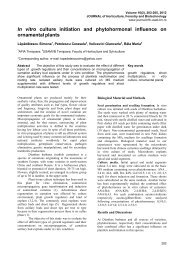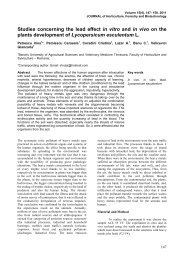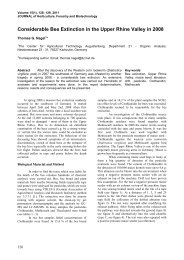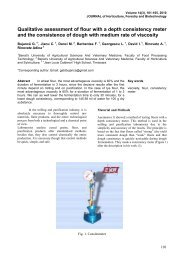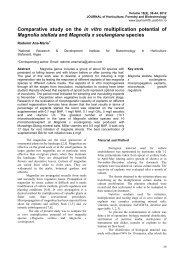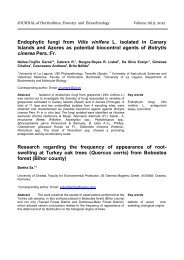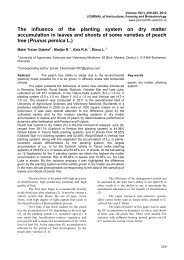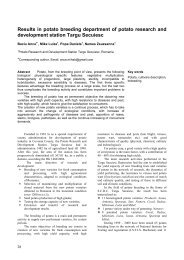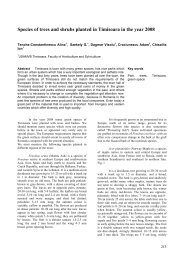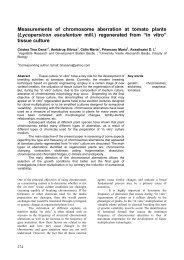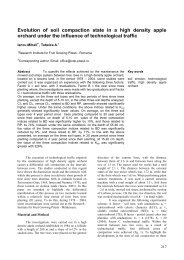Monitoring of nitrogen compounds content in underground water ...
Monitoring of nitrogen compounds content in underground water ...
Monitoring of nitrogen compounds content in underground water ...
Create successful ePaper yourself
Turn your PDF publications into a flip-book with our unique Google optimized e-Paper software.
Volume 16(4), 132- 135, 2012JOURNAL <strong>of</strong> Horticulture, Forestry and Biotechnologywww.journal-hfb.usab-tm.ro<strong>Monitor<strong>in</strong>g</strong> <strong>of</strong> <strong>nitrogen</strong> <strong>compounds</strong> <strong>content</strong> <strong>in</strong> <strong>underground</strong><strong>water</strong> from Timis riverBal<strong>in</strong>t (Panduru) Al<strong>in</strong>a 1* , Cîrciu G. 11 Banat’s University <strong>of</strong> Agricultural Sciences and Veter<strong>in</strong>ary Medic<strong>in</strong>e, Faculty <strong>of</strong> Horticulture and Forestry*Correspond<strong>in</strong>g author. Email: bal<strong>in</strong>tal<strong>in</strong>a29@yahoo.comAbstract The purpose <strong>of</strong> this paper is to present the results <strong>of</strong> monitor<strong>in</strong>gthe river Timis <strong>in</strong> terms <strong>of</strong> <strong>nitrogen</strong> <strong>compounds</strong> <strong>content</strong> <strong>in</strong> the period2011. Experimental were determ<strong>in</strong>ed <strong>nitrogen</strong> <strong>compounds</strong> (nitrate, nitrite,ammonium) <strong>in</strong> wells from six localities situated along the river Timis Slat<strong>in</strong>a-Timis Caransebes, Gavojdia, Cebza, Graniceri, Lugoj po<strong>in</strong>ts distributedbetween the source and the po<strong>in</strong>t out <strong>of</strong> the river, namely the border withSerbia. Samples determ<strong>in</strong>ations were done with the help <strong>of</strong>Spectrophotometer SQ 118. In autumn and w<strong>in</strong>ter months, concentrations <strong>of</strong><strong>nitrogen</strong> <strong>compounds</strong> have higher values and are due to frequent ra<strong>in</strong>fallrecorded dur<strong>in</strong>g this period <strong>of</strong> year. Samples analyzed from drill<strong>in</strong>g along theTimis River, are characterized with low nitrates, nitrites and ammonium ion<strong>content</strong>. In July 2011, concentrations <strong>of</strong> <strong>nitrogen</strong> <strong>compounds</strong> have maximumvalues and are due to excessive ra<strong>in</strong>fall <strong>of</strong> 107.9 mm.Key wordsnitrates, nitrites, ammonia,<strong>water</strong>, Timis riverTimis River, the richest <strong>water</strong> resources <strong>in</strong> the Area <strong>of</strong>Banat River bas<strong>in</strong> dra<strong>in</strong>s an area <strong>of</strong> over 5677 km ². Hislength is 244 km [8]. Timis has its sources on theeastern slopes <strong>of</strong> the mounta<strong>in</strong>s Semenic <strong>in</strong> Caras-Sever<strong>in</strong>. River is formed at the confluence <strong>of</strong> threebranches: Semenic Gradiste and Brebu. Overcom<strong>in</strong>gthe barrier <strong>of</strong> the Three Waters, stormy river flows <strong>in</strong> anarrow channel oriented NW - SE. From the TimisTeregova take direction from south to north, and fromCaransebes, due to lower slope, the river meandersdescribes large [8]. In the category <strong>of</strong> pollut<strong>in</strong>g factors<strong>of</strong> surface and depth is an important chemical<strong>compounds</strong>. A first effect <strong>of</strong> chemical pollution is thepotential for toxic chemicals. Among the chemical<strong>compounds</strong> with toxic effects on the human body animportant role has <strong>nitrogen</strong> <strong>compounds</strong> (nitrates,nitrites, ammonium) [9].Follow<strong>in</strong>g the biological effects caused by chemicalpollutants, legislation <strong>of</strong> countries technologicallyadvanced, or with a strong chemical <strong>in</strong>dustry,considered and imposed limits that must not exceed theconcentrations <strong>of</strong> pollutants <strong>in</strong> the environment (themaximum allowable limit - MAL) [4].Nitrogen <strong>compounds</strong> (ammonia, nitrites and nitrates)are important steps <strong>in</strong> the presence <strong>of</strong> <strong>in</strong>organic<strong>nitrogen</strong> <strong>in</strong> its complex cycle <strong>in</strong> nature [2]. Nitratesmay be either obta<strong>in</strong> synthetically or used as fertilizer.Industrial nitrates are produce on a large scale, nitricacid, ammonium formed by catalytic oxidation. Nitrite(NO - 2) is also a metabolite <strong>in</strong> the biological <strong>nitrogen</strong>cycle, both as an <strong>in</strong>termediate compound <strong>in</strong> thenitrification and denitrification process. Effect <strong>of</strong><strong>nitrogen</strong> pollutants on the environment due toanthropogenic sources <strong>of</strong> data us<strong>in</strong>g syntheticfertilizers <strong>in</strong> agriculture and horticulture cropfertilization, and because <strong>of</strong> waste from livestock farmscultivated soils. Literature studies have <strong>in</strong>dicated thatthe waste produced with<strong>in</strong> 7-8 cattle, can be use on onehectare <strong>of</strong> land and implement<strong>in</strong>g this high dose may<strong>in</strong>crease nitrate levels above 10 mg /L <strong>in</strong> ground<strong>water</strong>[1].The existence <strong>of</strong> ammonium ion concentration <strong>in</strong> <strong>water</strong>and absence <strong>of</strong> nitrates <strong>in</strong>dicate a recent <strong>water</strong>contam<strong>in</strong>ation. When <strong>water</strong> conta<strong>in</strong>s both ammoniaand nutrient <strong>in</strong>dicates a pollution s<strong>in</strong>ce that passed acerta<strong>in</strong> period. Lack <strong>of</strong> ammonia, but the presence <strong>of</strong>nitrates and nitrites, <strong>in</strong>volves a contam<strong>in</strong>ation thatoccurred a long time ago. Therefore, <strong>in</strong> this time, <strong>water</strong>was self-cleaned [2].Material and MethodExperimental were determ<strong>in</strong>ed <strong>nitrogen</strong> <strong>compounds</strong>(nitrate, nitrite, ammonium) <strong>in</strong> wells from fivelocalities situated along the Timis river : Slat<strong>in</strong>a-Timis,Caransebes, Gavojdia, Cebza, Graniceri,Lugoj po<strong>in</strong>tsdistributed between the source and the po<strong>in</strong>t out <strong>of</strong> theriver, namely the border with Serbia. Samples weretaken quarterly, dur<strong>in</strong>g one year 2011, the results were<strong>in</strong>terpreted accord<strong>in</strong>g to the requirements <strong>of</strong> the Law458/2002 regard<strong>in</strong>g chemical parameters <strong>of</strong> <strong>water</strong>quality [7]. Sampl<strong>in</strong>g po<strong>in</strong>ts are shown <strong>in</strong> Table 1. Thetests used for <strong>nitrogen</strong> <strong>compounds</strong> from <strong>water</strong> sampleswere SPECTROQUANT NITRATE 14773,SPECTROQUANT NITRITE 14776 andSPECTROQUANT AMONIUM 14752. Thedeterm<strong>in</strong>ations were made <strong>in</strong> Laboratory for theMeasurement <strong>of</strong> Residues <strong>of</strong> the Department <strong>of</strong> Agro-132
techniques <strong>of</strong> the U.S.A-V.M.B <strong>in</strong> Timisoara, with thehelp <strong>of</strong> SQ 118 Spectrophotometer at wavelengths:515 nm, 525 nm, 690 nm for nitrate, nitrite,respectively ammonium.Maximum admitted value for <strong>nitrogen</strong> <strong>compounds</strong> <strong>in</strong>dr<strong>in</strong>k<strong>in</strong>g <strong>water</strong> accord<strong>in</strong>g to the Law nr. 458/2002 ondr<strong>in</strong>k<strong>in</strong>g <strong>water</strong> quality are 50 mg/L (nitrate), 0,50 mg/L(nitrite) and 0,50 mg/L (ammonia) [7].Sampl<strong>in</strong>gpo<strong>in</strong>tsSlat<strong>in</strong>a- TimisCaransebesGavojdiaCebzaGraniceriLugojCharacteristicsSampl<strong>in</strong>g po<strong>in</strong>ts descriptionsThe sampl<strong>in</strong>g po<strong>in</strong>t is located on the upper reaches <strong>of</strong> the Timis river and can beconsidered, as a reference po<strong>in</strong>t, a witness, be<strong>in</strong>g located upstream <strong>of</strong> potentialpollution po<strong>in</strong>t sources such as Caransebes, Lugoj cities or some factories andlivestock complexes.The sampl<strong>in</strong>g po<strong>in</strong>t is located near the <strong>water</strong> <strong>in</strong>take for dr<strong>in</strong>k<strong>in</strong>g <strong>water</strong> abstraction <strong>in</strong>the city <strong>water</strong> plant No.2 Caransebes. Timis river <strong>water</strong> is used to supply the fivewells (S = 1800 m²) that complement the <strong>underground</strong> flow <strong>of</strong> 15 wells which provide25% <strong>of</strong> the needed <strong>water</strong> <strong>of</strong> city <strong>of</strong> CaransebesThe sampl<strong>in</strong>g po<strong>in</strong>t is located downstream <strong>of</strong> the junction po<strong>in</strong>ts <strong>of</strong> Timis with Nădragand Spaia streams and Bistra River, possible pollution sources <strong>of</strong> the Timis, butsituated before Lugoj city, a major source <strong>of</strong> pollution. To a small distance, about 10-15 km downstream, there is no. 2 dr<strong>in</strong>k<strong>in</strong>g <strong>water</strong> plant Lugoj.Sampl<strong>in</strong>g po<strong>in</strong>t is located downstream <strong>of</strong> the Timis-Bega River splitt<strong>in</strong>g po<strong>in</strong>t,downstream from the discharge <strong>of</strong> sewage from the city <strong>of</strong> Lugoj.The sampl<strong>in</strong>g po<strong>in</strong>t is located close to the border with Serbia, about 7 km downstreamfrom the confluence with the streams –Birda-Lanca that collects waste<strong>water</strong> fromlivestock belong<strong>in</strong>g to Ciacova farm and downstream <strong>of</strong> the pig farm Peciu whichdischarg<strong>in</strong>g sewage directly <strong>in</strong>to the Timis river.The sampl<strong>in</strong>g po<strong>in</strong>t is located dawnstream <strong>of</strong> the Cebza po<strong>in</strong>t and theTimis river go through aprox.4 kilometers,div<strong>in</strong><strong>in</strong>g it <strong>in</strong> two parts.Table 1140120100806040200I II III IV V VI VII VIII IX X XI XIIFig. 1. Ra<strong>in</strong>fall (mm) monthly average recorded <strong>in</strong> 2010 - 2012 and annual average201020112012mediamultianualaFrom Figure 1, can be observed oscillations <strong>in</strong>very large limits, so August 2011 and November 2011were extremely dry (1.3 mm - 0,2 mm) and July 2011was characterized by excessive ra<strong>in</strong>fall (107.9 mm)which had direct <strong>in</strong>fluence on the accumulation <strong>of</strong><strong>nitrogen</strong> <strong>compounds</strong> <strong>in</strong> ground<strong>water</strong>.Results and DiscussionsThe obta<strong>in</strong>ed experimental results are shown <strong>in</strong> tables2-4.The nitrate (NO - 3 ) (mg/L) <strong>content</strong> <strong>in</strong> <strong>water</strong> samples <strong>in</strong> monitored sampled po<strong>in</strong>ts <strong>in</strong> 2011LOCATION JANUARY APRIL JULY OCTOMBER AVERAGE ±SDLugoj 5.2 6.1 15.6 4.8 7.93±5.14Gavojdia 2.5 3.5 9.8 3.9 4.92±3.30Caransebes 5.9 5.5 16.8 7.8 9.00±5.29Slat<strong>in</strong>a-Timis 3.3 3.6 9.3 8.8 6.25±3.24Cebza 10.7 2.3 21.3 12.1 11.6±7.78Graniceri 2.0 2.7 6.3 7.8 4.70±2.79Table 2133
In January 2011, the variation limits <strong>of</strong> nitrate<strong>content</strong> ranged from 2.0 mg / L (Graniceri) - 10.7 mg /L (Cebza), <strong>in</strong> April the range value was between 2.3mg / L (Cebza) - 6.1 mg / L (Lugoj). It can be observedfrom Table 2 higher values <strong>of</strong> nitrate <strong>content</strong> <strong>in</strong> July,<strong>in</strong> all sampl<strong>in</strong>g po<strong>in</strong>ts. Interval rang<strong>in</strong>g between 6.3 mg/L (Graniceri) and 21.2 mg/L (Cebza), this is due toexcessive ra<strong>in</strong>fall fallen <strong>in</strong> June <strong>of</strong> 107.9 mm. Risk <strong>of</strong>nitrate losses <strong>in</strong> the soil because <strong>of</strong> ra<strong>in</strong>fall it appears <strong>in</strong>months when the ra<strong>in</strong>fall is <strong>in</strong> large amount and lowgrowth plants and low consumption <strong>of</strong> <strong>nitrogen</strong>. As aconsequence <strong>in</strong> this period can be expected <strong>in</strong>creases <strong>of</strong>nitrate <strong>content</strong> <strong>in</strong> ground<strong>water</strong> [3].Table 3The nitrite (NO - 2 ) (mg/L) <strong>content</strong> <strong>in</strong> <strong>water</strong> samples <strong>in</strong> monitored sampled po<strong>in</strong>ts <strong>in</strong> 2011LOCATION JANUARY APRIL JULY OCTOMBER AVERAGE ± SDLugoj 0.08 0.13 0.21 0.19 0.15±0.06Gavojdia 0.10 0.10 0.19 0.21 0.14±0.07Caransebes 0.05 0.22 0.14 0.18 0.15±0.07Slat<strong>in</strong>a-Timis 0.09 0.11 0.25 0.16 0.21±0.13Cebza 0.03 0.22 0.32 0.28 0.17±0.11Graniceri 0.02 0.16 0.26 0.22 0.15±0.06Values <strong>of</strong> nitrite <strong>content</strong> <strong>in</strong> the analyzed samples werewith<strong>in</strong> the limit values set by standards, <strong>of</strong> 0.5 mg /L,the highest values were recorded <strong>in</strong> July with valuesthat ranged between 0.14 mg/L (Caransebes) and 0.32mg/L (Cebza). The average for those 4 monthsmonitored ranged between 0.14 mg/L (Gavojdia) and0.21 mg/L ( Slat<strong>in</strong>a –Timis) (table 3).Ten years ago researches made <strong>in</strong> the studiedarea discovered very high ammonia <strong>content</strong> <strong>of</strong> 0.84mg/L <strong>in</strong> Gavojdia sampl<strong>in</strong>g po<strong>in</strong>t, that is locateddownstream <strong>of</strong> the confluence with the streams –Birda-Lanca that collected waste<strong>water</strong> from livestockbelong<strong>in</strong>g to Ciacova farm and downstream <strong>of</strong> the pigfarm Peciu which discharged sewage directly <strong>in</strong>to theTimis river. Accord<strong>in</strong>g to researches made <strong>in</strong> 2011 theproblem was resolved and those farms implemented anecological discharge for sewage <strong>in</strong> special conta<strong>in</strong>ers.Table 4The ammonium (NH + 4 ) (mg/L) <strong>content</strong> <strong>in</strong> <strong>water</strong> samples <strong>in</strong> monitored sampled po<strong>in</strong>ts <strong>in</strong> 2011LOCATION JANUARY APRIL JULY OCTOMBER MEDIA±SDLugoj 0.021 0.137 0.215 0.003 0.094±0.10Gavojdia 0.022 0.041 0.109 0.002 0.044±0.05Caransebes 0.024 0.053 0.099 0.003 0.045±0.04Slat<strong>in</strong>a-Timis 0.020 0.065 0.074 0.002 0.040±0.03Cebza 0.100 0.068 0.081 0.028 0.069±0.03Graniceri 0.102 0.050 0.075 0.013 0.060±0.04In 2011, there was a decrease <strong>of</strong> ammonium <strong>content</strong> <strong>in</strong>October, the values ranged between 0.002 mg/L(Gavojdia, Slat<strong>in</strong>a –Timis) and 0.028 mg/L (Cebza).Higher values were registered <strong>in</strong> July, <strong>of</strong> 0.074 mg/L(Slat<strong>in</strong>a - Timis) and 0.215 mg/L (Lugoj) correlatedwith the ra<strong>in</strong>fall level recorded <strong>in</strong> this month (table 4).The studies presented <strong>in</strong> this paper are <strong>in</strong> accordancewith other studies conducted by the Faculty <strong>of</strong>Horticulture and Forestry <strong>in</strong> 2000, made byLăzureanu, A., et all., [4] , 2006 by Cozma et all., [3]and Popoviciu Lenuta <strong>in</strong> period 2010-2011 [5,6].Conclusions-Analyzed samples from wells along the Timis River,are characterized by low <strong>content</strong> <strong>of</strong> nitrates, nitrites,and ammonium ion concentration. The existence <strong>of</strong>ammonium ion <strong>in</strong> <strong>water</strong> and lack <strong>of</strong> nitrates <strong>in</strong>dicate arecent <strong>water</strong> contam<strong>in</strong>ation.- Were registered higher values <strong>of</strong> nitrate <strong>content</strong> <strong>in</strong>July, <strong>in</strong> all sampl<strong>in</strong>g po<strong>in</strong>ts. Interval rang<strong>in</strong>g between6.3 mg /L (Graniceri) and 21.2 mg/L (Cebza), this isdue to excessive ra<strong>in</strong>fall fallen <strong>in</strong> June <strong>of</strong> 107.9 mm.- Values <strong>of</strong> nitrite <strong>content</strong> <strong>in</strong> the analyzed samples werewith<strong>in</strong> the limit values set by standards, <strong>of</strong> 0.5 mg /L,the highest values were recorded <strong>in</strong> July with valuesthat ranged between 0.14 mg/L (Caransebes) and 0.32mg/L (Cebza). The average for those 4 monthsmonitored ranged between 0.14 mg/L (Gavojdia) and0.21 mg/L ( Slat<strong>in</strong>a –Timis)- In July 2011, concentrations <strong>of</strong> <strong>nitrogen</strong> <strong>compounds</strong>have maximum values and are due to excessive ra<strong>in</strong>fall<strong>of</strong> 107.9 mm, recorded dur<strong>in</strong>g this time <strong>of</strong> year.ReferencesAdriano Canzian, Cater<strong>in</strong>a Sollazzo, Tiziana Mazza,Francesco Mundo, (2003): The implementation <strong>of</strong> the134
nitrates directive at national level, Journal <strong>of</strong>Environmental Quality 32:515-525,Alexa Ersilia, (2008): Contam<strong>in</strong>ants <strong>in</strong> horticulturaland cereal products, Solness Publish<strong>in</strong>g House,Timisoara.Cozma, Antoanela., Alexa, Ersilia, Lazureanu, Aurel,Poiana, Mariana, Dragunescu, Anca, (2006):Researches concern<strong>in</strong>g the ground <strong>water</strong> contam<strong>in</strong>ationwith <strong>nitrogen</strong> <strong>compounds</strong>, pesticides and heavy metals<strong>in</strong> the limitroph Timisoara area, Cercetari Sti<strong>in</strong>tifice,49, Seria Agronomie, p. 202-206.Lăzureanu, A., Cuc Liana, Alexa Ersilia, (2000):Contam<strong>in</strong>area apei cu nitraţi, nitriţi, şi amoniu în zonarurală a Banatului", Simpozionul Naţional de Chimie,Râmnicu Vâlcea;Popoviciu Gheorgh<strong>in</strong>a-Lenuta, Lazureanu, A., (2011):Determ<strong>in</strong>ation <strong>of</strong> quality parameters <strong>in</strong> <strong>water</strong> fromwells and founta<strong>in</strong>s <strong>of</strong> Birda farm, Timis county, 3rdInternational Conference Research People and ActualTasks on Multidiscipl<strong>in</strong>ary Sciences, Volume 1, ISSN1313-7735, 8 – 10 June, Lozenec, pp. 47-50.Popoviciu Gheorgh<strong>in</strong>a-Lenuţa, Aurel Lazureanu,(2010): Contam<strong>in</strong>ation <strong>of</strong> surface and deep <strong>water</strong> <strong>in</strong>Timis county area, AGRObulet<strong>in</strong> AGIR, Editat deSocietatea de Ing<strong>in</strong>erii Agricole Timiş, Anul II-IIINr. 7(dec./febr.) ISSN 2066-6179, pp. 64-67.*** Legea 458/2002 - Parametrii chimici de calitate aiapei potabile.***http://ro.wikipedia.org/wiki/R%C3%A2ul_Timi%C8%99,_Dun%C4%83re***European Directive 98/83/EC <strong>water</strong> quality forhuman consumption.135



